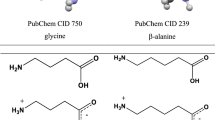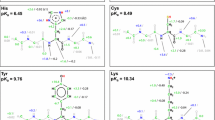Abstract
The ionization of short weak polyelectrolytes in dilute solutions is investigated by 1H nuclear magnetic resonance (NMR). The increase of the pH of the medium causes both the ionization of the polyacids and, due to the intra-molecular repulsions, the swelling of the chains. As a result, a noticeable effect of the pH change on the NMR chemical shift δ, and on the self-diffusion coefficient D is observed. The ionization of the polyelectrolyte occurs at higher pH as the length of the chain increases. The variation of the self-diffusion coefficient with pH exhibits the opposite dependence on the length of the chain. However, no detectable effect of the length of the polyelectrolyte chain on the evolution of the chemical shift with pH is observed. These apparent contradictions are examined to clarify the impact of the chain length on the polyelectrolyte properties, and the counterion role in the ionization process.






Similar content being viewed by others
References
Jiang X, Yin Y, Wang C, Tian X (2014) Decolorization of anionic dye solutions using the hydrophobically modified polyelectrolytes containing beta-cyclodextrin moieties. Chem Eng J 253:183–189
Yi C, Hu R, Ren H, Hu X, Wang S, Gong X, Cao Y (2014) Protonation process of conjugated polyelectrolytes on enhanced power conversion efficiency in the inverted polymer solar cells. J Photonics Energy 4:043,099–043,108
Brandrup J, Immergut EH, Grulke EA (1999) Polymer handbook, vol 2, 4th edn. Wiley Interscience, New York
Knappe P, Bienert R, Weidner S, Thuenemann AF (2010) Poly(acrylic acid): a combined analysis with field-flow fractionation and SAXS. Macromol Chem Phys 211(19):2148–2153
Roger GM, Durand-Vidal S, Bernard O, Mériguet G., Altmann S, Turq P (2010) Characterization of humic substances and polyacrylic acid: a high precision conductimetry study. Colloids Surf A 356(1-3):51–57
Laguecir A, Ulrich S, Labille J, Fatin-Rouge N, Stoll S, Buffle J (2006) Size and pH effect on electrical and conformational behavior of poly(acrylic acid): simulation and experiment. Eur Polym J 42(5):1135–1144
Schweins R, Hollmann J, Huber K (2003) Dilute solution behaviour of sodium polyacrylate chains in aqueous NaCl solutions. Polymer 44(23):7131–7141
Gonzalez G, de la Cal JC, Asua JM (2011) Flocculation efficiency of blends of short and long chain polyelectrolytes. Colloids Surf A 385(1-3):166–170
Yu S, Xu X, Yigit C, van der Giet M, Zidek W, Jankowski J, Dzubiella J, Ballauff M (2015) Interaction of human serum albumin with short polyelectrolytes: a study by calorimetry and computer simulations. Soft Matter 11(23):4630–4639
Swift T, Swanson L, Geoghegan M, Rimmer S (2016) The pH-responsive behaviour of poly(acrylic acid) in aqueous solution is dependent on molar mass. Soft Matter 12(9):2542–2549
Price W (2009) NMR studies of translational motion: principles and applications. Cambridge molecular science. Cambridge University Press
Scheler U (2009) NMR on polyelectrolytes. Curr Opin Colloid Interface Sci 14(3):212–215
Callaghan P (2011) Translational dynamics and magnetic resonance: principles of pulsed gradient spin echo NMR. OUP, Oxford
Hatada K, Kitayama T (2004) NMR spectroscopy of polymers. Springer, Berlin
Saalwächter K, Reichert D (2010) Polymer applications of NMR. In: Encycl. Spectrosc. Spectrom. Elsevier, pp 2221–2236.
Walderhaug H, Söderman O, Topgaard D (2010) Self-diffusion in polymer systems studied by magnetic field-gradient spin-echo NMR methods. Prog Nucl Magn Reson Spectrosc 56(4):406–425
Šarac B, Mériguet G, Ancian B, Bešter-Rogač M (2013) Salicylate isomer-specific effect on the micellization of dodecyltrimethylammonium chloride: large effects from small changes. Langmuir 29(14):4460–4469
Giesecke M, Mériguet G, Hallberg F, Fang Y, Stilbs P, Furó I (2015) Ion association in aqueous and non-aqueous solutions probed by diffusion and electrophoretic NMR. Phys Chem Chem Phys 17(5):3402–3408
Hostnik G, Bončina M, Dolce C, Mériguet G, Rollet AL, Cerar J (2016) Influence of counterions on the conformation of conjugated polyelectrolytes: the case of poly(thiophen-3-ylacetic acid). Phys Chem Chem Phys 18(36):25,036–25,047
Bezencon J, Wittwer MB, Cutting B, Smiesko M, Wagner B, Kansy M, Ernst B (2014) pK(a) determination by H-1 NMR spectroscopy—an old methodology revisited. J Pharm Biomed Anal 93:147–155
Pristinski D, Kozlovskaya V, Sukhishvili SA (2005) Fluorescence correlation spectroscopy studies of diffusion of a weak polyelectrolyte in aqueous solutions. J Chem Phys 122(1):14,907
McDonough R, Cueto R, Phillies GDJ, Russo PS, Dorman D, Streletzky KA (2015) Fluorescent labeling can alter polymer solution dynamics. Macromolecules 48(19):7245–7255
Sedlák M (2001) Structure and dynamics of polyelectrolyte solutions by light scattering. In: Radeva T (ed) Physical chemistry of polyelectrolytes, surfactant science series, vol 99. Marcel Dekker, Inc, New York, pp 1–58
Ise N, Okubo T, Yamamoto K, Kawai H, Hashimoto T, Fujimura M, Hiragi Y (1980) Ordered structure in dilute solutions of ionic biopolymers. 2. Small-angle X-ray scattering study of sodium polyacrylate solution. J Am Chem Soc 102(27):7901–7906
Muroga Y, Noda I, Nagasawa M (1985) Investigation of local conformations of polyelectrolytes in aqueous solution by small-angle X-ray scattering. 1. Local conformations of poly(sodium acrylates). Macromolecules 18(8):1576–1579
Saito T, Shimada K, Kinugasa S (2004) Determination of the size of a polystyrene nanosphere by the pulsed field gradient nuclear magnetic resonance method. Langmuir 20(11):4779–4781
Kestin J, Khalifa H, Correia R (1981) Tables of the dynamic and kinematic viscosity of aqueous NaCl solutions. J Phys Chem Ref Data 10(1):71–87
Teraoka I (2002) Polymer solutions: an introduction to physical properties. Wiley, New York
Cosgrove T, Griffiths P (1994) The critical overlap concentration measured by pulsed-field gradient nuclear-magnetic-resonance techniques. Polymer 35(3):509–513
Majer G, Zick K (2015) Accurate and absolute diffusion measurements of Rhodamine 6G in low-concentration aqueous solutions by the PGSE-WATERGATE sequence. J Chem Phys 142(16):164,202
Price WS (1997) Pulsed-field gradient nuclear magnetic resonance as a tool for studying translational diffusion: part 1. Basic theory. Concepts Magn Reson 9(5):299–336
Wu DH, Chen AD, Johnson CS (1995) An improved diffusion-ordered spectroscopy experiment incorporating bipolar-gradient pulses. J Magn Reson, Ser A 115(2):260–264
Holz M, Heil SR, Sacco A (2000) Temperature-dependent self-diffusion coefficients of water and six selected molecular liquids for calibration in accurate 1H NMR PFG measurements. Phys Chem Chem Phys 2(20):4740–4742
Holz M, Weingartner H (1991) Calibration in accurate spin-echo self-diffusion measurements using H-1 and less-common nuclei. J Magn Reson 92(1):115–125
Stepto RFT (2009) Dispersity in polymer science (IUPAC Recommendations 2009). Pure Appl Chem 81(2):351–353
Callaghan PT, Lelievre J (1985) The size and shape of amylopectin: a study using pulsed-field gradient nuclear magnetic resonance. Biopolymers 24(3):441–460
Håkansson B, Nydén M, Söderman O (2000) The influence of polymer molecular-weight distributions on pulsed field gradient nuclear magnetic resonance self-diffusion experiments. Colloid Polym Sci 278(5):399–405
Oostwal MG, Blees MH, De Bleijser J, Leyte JC (1993) Chain self-diffusion in aqueous salt-free solutions of sodium poly(styrenesulfonate). Macromolecules 26(26):7300–7308
Roding M, Bernin D, Jonasson J, Sarkka A, Topgaard D, Rudemo M, Nyden M (2012) The gamma distribution model for pulsed-field gradient NMR studies of molecular-weight distributions of polymers. J Magn Reson 222:105–111
Borkovec M, Jönsson B, Koper GJM (2001) Ionization processes and proton binding in polyprotic systems: small molecules, proteins, interfaces, and polyelectrolytes. In: Matijević E (ed) Surface and colloid science, vol 16. Springer, US, Boston, MA, pp 99–339
Sadeghpour A, Vaccaro A, Rentsch S, Borkovec M (2009) Influence of alkali metal counterions on the charging behavior of poly(acrylic acid). Polymer 50(16):3950–3954
Henderson LJ (1908) Concerning the relationship between the strength of acids and their capacity to preserve neutrality. Am J Physiol 21(2):173–179
Hasselbalch KA (1916) Die Berechnung der Wasserstoffzahl des blutes auf der freien und gebundenen Kohlensaure desselben, und die Sauerstoffbindung des Blutes als Funktion des Wasserstoffzahl. Biochem Z 78:112–144
Annenkov VV, Kruglova VA, Mazyar NL (1998) Analysis of the potentiometric titration curves within the framework of the theory of the “neighbor effect”. J Polym Sci Part B Polym Phys 36(6):931–936
Carnal F, Ulrich S, Stoll S (2010) Influence of explicit ions on titration curves and conformations of flexible polyelectrolytes: a Monte Carlo study. Macromolecules 43(5):2544–2553
Ullner M, Jönsson B, Söderberg B, Peterson C (1996) A Monte Carlo study of titrating polyelectrolytes. J Chem Phys 104(8):3048–3057
Ullner M, Jönsson B, Widmark PO (1994) Conformational properties and apparent dissociation constants of titrating polyelectrolytes: Monte Carlo simulation and scaling arguments. J Chem Phys 100(4):3365
Tynkkynen T, Tiainen M, Soininen P, Laatikainen R (2009) From proton nuclear magnetic resonance spectra to ph. assessment of 1H NMR pH indicator compound set for deuterium oxide solutions. Anal Chim Acta 648(1):105–12
Cistola DP, Small DM, Hamilton JA (1982) Ionization behavior of aqueous short-chain carboxylic acids: a carbon-13 NMR study. J Lipid Res 23(5):795–799
Chang C, Muccio DD, St. Pierre T (1985) Determination of the tacticity and analysis of the pH titration of poly(acrylic acid) by proton and carbon-13 NMR. Macromolecules 18(11):2154–2157
Buckingham A (1960) Chemical shifts in the nuclear magnetic resonance spectra of molecules containing polar groups. Can J Chem 38(2):300–307
Schneider WG, Bernstein HJ, Pople JA (1958) Proton magnetic resonance chemical shift of free (gaseous) and associated (liquid) hydride molecules. J Chem Phys 28(4):601
Neal S, Nip AM, Zhang H, Wishart DS (2003) Rapid and accurate calculation of protein 1H, 13C and 15N chemical shifts. J Biomol NMR 26(3):215–40
Platzer G, Okon M, Mcintosh LP (2014) pH-dependent random coil 1H, 13C, and 15N chemical shifts of the ionizable amino acids: a guide for protein pK a measurements. J Biomol NMR 60(2-3):109–129
Manning GS (1969) Limiting laws and counterion condensation in polyelectrolyte solutions I. Colligative properties. J Chem Phys 51(3):924–933
Reith D, Müller B, Müller-Plathe F, Wiegand S (2002) How does the chain extension of poly (acrylic acid) scale in aqueous solution? A combined study with light scattering and computer simulation. J Chem Phys 116(20):9100–9106
Callaghan PT, Pinder DN (1983) A pulsed field gradient NMR study of self-diffusion in a polydisperse polymer system: dextran in water. Macromolecules 16(6):968–973
Kulicke WM, Clasen C (2004) Viscosimetric determination of the molar mass. In: Viscosimetry polym. Polyelectrolytes, Springer Laboratory. Springer, Berlin, pp 69–89
Dunn L, Stokes R (1965) The diffusion of monocarboxylic acids in aqueous solution at 25∘. Aust J Chem 18(3):285–296
Cranford SW, Buehler MJ (2012) Variation of weak polyelectrolyte persistence length through an electrostatic contour length. Macromolecules 45(19):8067–8082
Acknowledgments
The authors thank Dr. Isabelle Correia (UPMC – Sorbonne Universités) for the NMR facilities and technical assistance and B. Ancian for fruitful discussions and UPMC for funding.
Author information
Authors and Affiliations
Corresponding author
Ethics declarations
Funding
This study was funded by UPMC.
Conflict of interests
The authors declare that they have no conflict of interest.
Electronic supplementary material
Below is the link to the electronic supplementary material.
Rights and permissions
About this article
Cite this article
Dolce, C., Mériguet, G. Ionization of short weak polyelectrolytes: when size matters. Colloid Polym Sci 295, 279–287 (2017). https://doi.org/10.1007/s00396-016-4000-x
Received:
Revised:
Accepted:
Published:
Issue Date:
DOI: https://doi.org/10.1007/s00396-016-4000-x




